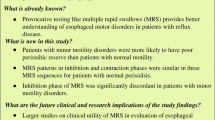Abstract
Objective: Impaired tubular esophageal motility is involved in the pathogenesis of gastroesophageal reflux disease, which, in turn, has been shown to cause nosocomial pneumonia in critically ill patients. As multiple factors are involved, this pilot study was undertaken to evaluate whether, similarly, impaired esophageal motility may contribute to nosocomial infections by determining esophageal motility in critically ill patients undergoing mechanical ventilation and sedation in comparison to that of a healthy control group. Design: Open, single-centered study. Patients and methods: Fifteen consecutive ventilated intensive care unit (ICU) patients with different diseases and three regimens of analgo-sedation were included: group 1: no analgo-sedation, group 2: ketamine and benzodiazepines, and group 3: fentanyl and benzodiazepines. Six healthy volunteers were studied as controls. Twenty-four hour esophageal anterograde (propulsive) and retrograde motility changes were assessed by a manometry system. Results: The frequencies of contractions were 0.67±0.1/min (no analgo-sedation) 0.093±0.02 (ketamine) and 0.076±0.01 (fentanyl) (p<0.05 as compared to controls). The amplitudes (% of maximum) were 98% (control), 58% (analgo-sedation), 38% (ketamine) and 42% (fentanyl; p<0.05 for the comparison of fentanyl and ketamine with controls). Whereas the percentage of propulsive contractions was significantly decreased in patients (no sedation: 45%, ketamine: 34%; fentanyl: 35%, p<0.05) as compared to controls (72%), the percentage of retrograde contractions increased: no sedation: 29%, ketamine: 34% and fentanyl: 37% as compared to controls: 10%, p<0.05. Analysis according to the underlying diseases showed marked inhibition of motility parameters within any disease group in comparison with controls. Conclusions: Irrespective of the underlying disease, propulsive motility of the esophageal body is significantly reduced during any kind of sedation in critically ill patients. Possibly central as well peripheral drug-related effects are involved in such a depression. Twenty-four hour motility recordings appear to be a valuable and feasible method to quantify and analyze esophageal motor disorders in critically ill patients.
Similar content being viewed by others
Author information
Authors and Affiliations
Additional information
Final revision received: 30 June 2000
Electronic Publication
Rights and permissions
About this article
Cite this article
Kölbel, C., Rippel, K., Klar, H. et al. Esophageal motility disorders in critically ill patients: a 24-hour manometric study. Intensive Care Med 26, 1421–1427 (2000). https://doi.org/10.1007/s001340000630
Received:
Accepted:
Published:
Issue Date:
DOI: https://doi.org/10.1007/s001340000630




